What Can Discolored A Baby Nails
The terms deformities and dystrophies are often used interchangeably, sometimes even by doctors. However, their meanings are slightly different.
-
Deformities: Changes in nail shape
-
Dystrophies: Changes in boom texture, color, or both
About l% of blast dystrophies are caused by a fungal infection (onychomycosis Onychomycosis Onychomycosis is a fungal infection of the nails. (See as well Overview of Nail Disorders.) About 10% of people take onychomycosis, which almost often affects the toenails rather than the fingernails... read more  ) . The remainder outcome from various causes, including nail injuries Fingernail and Toenail Injury Fingernails and toenails can be damaged by injuries. Even a modest injury to the finger or toe may cause changes in the nail. Astringent damage to the nail bed (the soft tissue underneath the nail... read more than
) . The remainder outcome from various causes, including nail injuries Fingernail and Toenail Injury Fingernails and toenails can be damaged by injuries. Even a modest injury to the finger or toe may cause changes in the nail. Astringent damage to the nail bed (the soft tissue underneath the nail... read more than  , birth deformities of the nails Nascency deformities of the boom The terms deformities and dystrophies are ofttimes used interchangeably, sometimes even by doctors. However, their meanings are slightly dissimilar. Deformities: Changes in smash shape... read more
, birth deformities of the nails Nascency deformities of the boom The terms deformities and dystrophies are ofttimes used interchangeably, sometimes even by doctors. However, their meanings are slightly dissimilar. Deformities: Changes in smash shape... read more  , psoriasis Psoriasis Psoriasis is a chronic, recurring disease that causes ane or more raised, red patches that take silvery scales and a distinct border between the patch and normal skin. A problem with the immune... read more
, psoriasis Psoriasis Psoriasis is a chronic, recurring disease that causes ane or more raised, red patches that take silvery scales and a distinct border between the patch and normal skin. A problem with the immune... read more 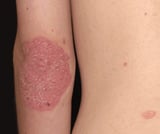 , lichen planus Lichen Planus Lichen planus, a recurring itchy illness, starts as a rash of small, divide, carmine or purple bumps that so combine and become rough, scaly patches. The cause may be a reaction to certain drugs... read more
, lichen planus Lichen Planus Lichen planus, a recurring itchy illness, starts as a rash of small, divide, carmine or purple bumps that so combine and become rough, scaly patches. The cause may be a reaction to certain drugs... read more  , and occasionally tumors (cancerous and noncancerous). Drugs, infections, and diseases tin can crusade discoloration of the nails (chromonychia). For example, infection with Pseudomonas bacteria tin can cause a greenish discoloration (meet Green Smash Syndrome Green Boom Syndrome Green boom syndrome is infection with Pseudomonas, a type of leaner. (Meet besides Overview of Blast Disorders.) The photo on the left shows green blast syndrome with onycholysis of the fourth... read more
, and occasionally tumors (cancerous and noncancerous). Drugs, infections, and diseases tin can crusade discoloration of the nails (chromonychia). For example, infection with Pseudomonas bacteria tin can cause a greenish discoloration (meet Green Smash Syndrome Green Boom Syndrome Green boom syndrome is infection with Pseudomonas, a type of leaner. (Meet besides Overview of Blast Disorders.) The photo on the left shows green blast syndrome with onycholysis of the fourth... read more  ).
).
The medico can often make the diagnosis of nail dystrophies caused by a fungus by examining the nails. Yet, to confirm the diagnosis, the doctor may demand to have fungal scrapings and do a culture (the process of growing the organisms in a laboratory) or practice a polymerase chain reaction (PCR) assay to look for genetic material from a fungus.
To diagnose nail dystrophies that are non caused by a fungus, doctors may exercise a biopsy of the nail plate (the hard function of the nail) or nail matrix (located at the base of operations of the nail and where nail growth originates).
If the boom's appearance does not better with handling of the underlying disorder, manicurists may be able to hide deformities and some dystrophies with appropriate trimming and polishes.
Sometimes, diseases that involve other organs (systemic diseases) can cause changes in the nails likewise, including the following:
-
Beau lines are horizontal grooves in the nail that occur when at that place is temporary slowing of growth of the nail. Sometimes the grooves can go all the fashion through the nail, leading to complete loss of the nail. They can occur later on an infection, injury, systemic illness, or chemotherapy.
-
White horizontal lines across part of the nail (leukonychia) may appear later on an injury. However, lines that run horizontally all of the fashion across the nail (Mees lines) may exist associated with more serious health problems, including cancer or heart failure, chemotherapy, or exposure to sure toxins, such as arsenic, thallium, or other heavy metals. The nails can grow out normally if exposure to these toxins or chemotherapy is stopped.
Sometimes, skin diseases also affect the boom unit and may change the appearance of the nails. Some drugs given to treat skin diseases tin can change the nail plate. For example, retinoids, such as isotretinoin and etretinate, can cause dryness and brittleness of the nails.
Drugs may cause other nail bug, such as melanonychia striata (brown or black pigmented lines) and onycholysis. Unlike drugs lead to discoloration of the nail, which unremarkably gets better after the drug is stopped and the blast grows out.
-
Chemotherapy drugs may crusade a darkening (hyperpigmentation) of the nail plate. Horizontal pigmented or white bands may besides exist seen in people treated with certain chemotherapy drugs.
-
Chloroquine, a drug used in the handling of parasitic infections and certain types of autoimmune diseases, can cause the nail bed to plow blueish-black.
-
Silver, which tin be captivated afterward occupational exposure or through taking dietary supplements containing colloidal silver protein, can cause the nails to turn a night bluish-gray.
-
Drugs that comprise gold, which is rarely used in the treatment of rheumatoid arthritis, can turn nails low-cal or dark chocolate-brown.
-
Tetracycline antibiotics, ketoconazole, sulfonamide antibiotics, phenindione, and phenothiazines can cause blueish or brown discoloration.
-
Arsenic poisoning can cause horizontal white lines to class on the nails or crusade the nails to turn brown.
In median nail dystrophy, pocket-sized cracks in the center of the nail extend to the sides and eventually look like the branches of an evergreen tree (such as a Christmas tree). The cause of median nail dystrophy is unknown in some cases, just repeated injuries, including frequent use of computer keyboards and similar devices, are thought to play a role. The person must stop injuring the nails. Treatment with tacrolimus ointment has been shown to assist in some cases.
Melanonychia striata are gray, brown, or blackness lines in the blast plate acquired by the normal, brown pare pigment, melanin. The lines extend from the base of the nail to its tip. In nighttime-skinned people, these lines may be normal and require no treatment. Other noncancerous causes of melanonychia striata include moles Moles Moles are modest, usually dark, peel growths that develop from paint-producing cells in the skin (melanocytes). Most people have some moles, but the trend to develop atypical moles is sometimes... read more 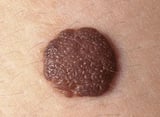 , HIV infection Human Immunodeficiency Virus (HIV) Infection Human immunodeficiency virus (HIV) infection is a viral infection that progressively destroys certain white blood cells and can cause acquired immunodeficiency syndrome (AIDS). HIV is transmitted... read more
, HIV infection Human Immunodeficiency Virus (HIV) Infection Human immunodeficiency virus (HIV) infection is a viral infection that progressively destroys certain white blood cells and can cause acquired immunodeficiency syndrome (AIDS). HIV is transmitted... read more  , hyperthyroidism Hyperthyroidism Hyperthyroidism is overactivity of the thyroid gland that leads to high levels of thyroid hormones and speeding up of vital torso functions. Graves disease is the almost mutual cause of hyperthyroidism... read more
, hyperthyroidism Hyperthyroidism Hyperthyroidism is overactivity of the thyroid gland that leads to high levels of thyroid hormones and speeding up of vital torso functions. Graves disease is the almost mutual cause of hyperthyroidism... read more  , utilise of certain drugs, pregnancy, nail injuries Fingernail and Toenail Injury Fingernails and toenails can exist damaged by injuries. Fifty-fifty a modest injury to the finger or toe may cause changes in the nail. Astringent impairment to the nail bed (the soft tissue underneath the nail... read more
, utilise of certain drugs, pregnancy, nail injuries Fingernail and Toenail Injury Fingernails and toenails can exist damaged by injuries. Fifty-fifty a modest injury to the finger or toe may cause changes in the nail. Astringent impairment to the nail bed (the soft tissue underneath the nail... read more  , Addison disease Addison Disease In Addison disease, the adrenal glands are underactive, resulting in a deficiency of adrenal hormones. Addison disease may exist caused by an autoimmune reaction, cancer, an infection, or some... read more
, Addison disease Addison Disease In Addison disease, the adrenal glands are underactive, resulting in a deficiency of adrenal hormones. Addison disease may exist caused by an autoimmune reaction, cancer, an infection, or some... read more 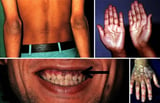 , and Cushing syndrome Cushing Syndrome In Cushing syndrome, the level of corticosteroids is excessive, usually due to taking corticosteroid drugs or overproduction by the adrenal glands. Cushing syndrome usually results from taking... read more
, and Cushing syndrome Cushing Syndrome In Cushing syndrome, the level of corticosteroids is excessive, usually due to taking corticosteroid drugs or overproduction by the adrenal glands. Cushing syndrome usually results from taking... read more 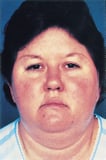 .
.
Onycholysis is fractional separation of the smash plate from the nail bed or consummate nail plate loss. Information technology can consequence from
-
An injury (such every bit in prolonged hiking or skiing with poorly fitted footwear)
-
Overzealous nail cleaning
-
Frequent exposure to water, citrus fruits, and certain chemicals (such as those in cleaning agents)
-
Treatment with doxorubicin, captopril, practolol, v-fluorouracil, and retinoids
Additionally, other drugs, such as doxycycline, psoralens, and fluoroquinolones, tin cause onycholysis after nails are exposed to sunlight (photograph-onycholysis).
People with onycholysis are at risk of infection with yeast and fungus. Keeping the nail dry and applying antifungal preparations to the smash unit can help.
In pincer smash deformity, the nail is overcurved horizontally (side-to-side). It is most often acquired by a fungal infection (onychomycosis Onychomycosis Onychomycosis is a fungal infection of the nails. (Come across also Overview of Blast Disorders.) Nearly ten% of people have onychomycosis, which most often affects the toenails rather than the fingernails... read more than  ), psoriasis Psoriasis Psoriasis is a chronic, recurring disease that causes one or more than raised, red patches that take silvery scales and a singled-out edge between the patch and normal skin. A problem with the allowed... read more
), psoriasis Psoriasis Psoriasis is a chronic, recurring disease that causes one or more than raised, red patches that take silvery scales and a singled-out edge between the patch and normal skin. A problem with the allowed... read more  , tumors of the smash Tumors of the Nails Noncancerous (benign) and cancerous (malignant) tumors can affect the nail unit of measurement, causing a changes in nail texture and/or color (dystrophy). Many of these are tumors that originate in tissues... read more than
, tumors of the smash Tumors of the Nails Noncancerous (benign) and cancerous (malignant) tumors can affect the nail unit of measurement, causing a changes in nail texture and/or color (dystrophy). Many of these are tumors that originate in tissues... read more than 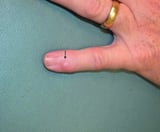 , and poorly fitting shoes. The deformity can also occur in people who have lupus Systemic Lupus Erythematosus (SLE) Systemic lupus erythematosus is a chronic autoimmune inflammatory connective tissue disorder that tin can involve joints, kidneys, pare, mucous membranes, and blood vessel walls. Issues in the... read more
, and poorly fitting shoes. The deformity can also occur in people who have lupus Systemic Lupus Erythematosus (SLE) Systemic lupus erythematosus is a chronic autoimmune inflammatory connective tissue disorder that tin can involve joints, kidneys, pare, mucous membranes, and blood vessel walls. Issues in the... read more 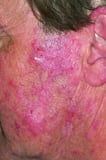 , Kawasaki affliction Kawasaki Affliction Kawasaki disease causes inflammation of blood vessels throughout the body. The cause of Kawasaki disease is unknown but may exist associated with an infection. Children typically accept fever, rash... read more than
, Kawasaki affliction Kawasaki Affliction Kawasaki disease causes inflammation of blood vessels throughout the body. The cause of Kawasaki disease is unknown but may exist associated with an infection. Children typically accept fever, rash... read more than 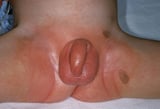 , end-stage renal illness (astringent chronic kidney disease Chronic Kidney Disease Chronic kidney disease is a slowly progressive (months to years) decline in the kidneys' power to filter metabolic waste product products from the blood. Major causes are diabetes and high blood pressure... read more ), and some genetic syndromes (for example, pachyonychia congenita). Sometimes it develops in older people and in those with arthritis in their fingers. People oftentimes take pain where the nail plate curves into the tips of the fingers.
, end-stage renal illness (astringent chronic kidney disease Chronic Kidney Disease Chronic kidney disease is a slowly progressive (months to years) decline in the kidneys' power to filter metabolic waste product products from the blood. Major causes are diabetes and high blood pressure... read more ), and some genetic syndromes (for example, pachyonychia congenita). Sometimes it develops in older people and in those with arthritis in their fingers. People oftentimes take pain where the nail plate curves into the tips of the fingers.
Source: https://www.msdmanuals.com/home/skin-disorders/nail-disorders/deformities-dystrophies-and-discoloration-of-the-nails
Posted by: hanfordtworiblest.blogspot.com


0 Response to "What Can Discolored A Baby Nails"
Post a Comment